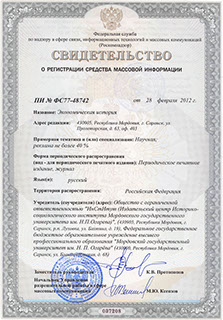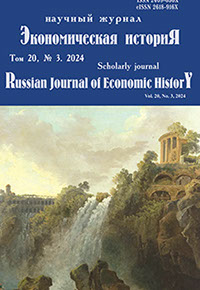Экономическая историЯ
Russian Journal of Economic History
ISSN 2409-630X (Print)
ISSN 2618-916X (Online)
Expert board:
- Scientific Council of RAS on economic history;
- Research and Educational Center «The economic history of Central Russia and the Middle Volga region» of Ogarev Mordovia State University;
- Center of Economic History of Lomonosov Moscow State University
Navigation
Certificate of registration

УДК ГРНТИ 03.23.55
Vladimir V. Zapariy
Ural Federal University named after the First President of Russia B. N. Yeltsin, (Ekaterinburg, Russia),
e-mail: vvzap@mail.ru
About Giantomania, or the Necessity to Use Resources for restoration of Liberated Territories: on the Question of the Feedability
of Construction of the Alapayevsk Machine Building Plant
Abstract
Introduction. One of the largest machine tool factories in the Urals is the Alapaevsky Machine Building Plant, built during the Great Patriotic War. Its appearance was not without clouds, not only because it was built during the war years. The plant produced its products for the next 70 years. The Alapaevsk Machine Building Plant produced more than 50 thousand units of turret lathes, screw-cutting lathes and special machines. The plant’s 150 models continue to operate successfully in 44 countries around the world and in more than thousands of domestic enterprises. The article is devoted to a small but significant moment in the history of the Great Patriotic War and the history of the creation of the Alapaevsky Machine Building plant in the Urals, which was built in difficult war conditions.
Results. One of its technical specialists wrote to the Party Central Committee, arguing for the need to use the resources allocated for its construction to help boost industry in the liberated regions of the country. In it, he describes the situation with the construction of the NPP, where he gives a detailed description of this process, and proves its inconsistency and repeatedly asks the question. With great difficulty, at great expense and in the difficult climatic conditions of the Urals, a machine shop was erected, machine tools were installed and the plant began its existence, as he claims, “limping on all four legs” .Why does this construction stubbornly continue, although it is obvious to him that it should be revised, and people and funds should be directed to other goals. He talks about “wouldn’t it be better to build and restore the liberated areas at this expense?”
“What calmed the heart”. The Central Committee of the All-Union Communist Party of Bolsheviks and the personnel department received a response. Based on the one built in 1942–1943. the first stage building and a temporary foundry, the production of small turret machines of type 1322 was organized. It is noted that the main reasons for the unsatisfactory progress of construction in 1944 were the lack of workers, transport and auxiliary materials. The regional authorities ask to complete the approval of the project and finally establish the profile and capacity of the plant for the production of machine tools; provide the plant with additional construction workers for less than 2 000 people; establish the volume of construction work for 1945 at least 25 million rubles. and provide the construction site with transport, fuel, fodder and warm clothing.
Conclusion. By the time of the discussion, the complainant himself had left for the liberated regions and his fate is unknown. But the shortcomings he pointed out were eliminated to one degree or another. However, the very manifestation of the aspirations of ordinary citizens of the Soviet Union, aimed at caring about the fate of the liberated regions and the need to assist them in the rise of industry, is worth a lot. And this story is a worthy example of this. And the plant was completed and became an adornment of the USSR Ministry of Machine Tool Industry.
Keywords: The Great Patriotic War, Alapaevsk Machine Building Plant, Central Committee of the All-Union Communist Party of Bolsheviks, assistance to the liberated regions of the USSR.
For citation: Zapariy V. V. About Giantomania, or the Necessity to Use Resources for restoration of Liberated Territories: on the Question of the Feedability of Construction of the Alapayevsk Machine Building Plant. Economicheskaya istoriya = Russian Journal of Economic History. 2024; 20(3): 278–284. (In Russ.).
Acknowledgements: The study was supported by a grant from the Russian Science Foundation No. 24-28-00837.
© Ogarev Mordovia State University. History and Sociology Institute, 2017
68, Of. 411, Bolshevistskaya St., 430005, The editorial office of the scholarly journal «Russian Journal of Economic History»
Tel.: (8342) 24-25-90; 27-07-11, Fax: (8342) 24-25-90, E-mail: jurnal-econom-hist@isi.mrsu.ru
Designed by A. Napalkov, Email: napalkov@isi.mrsu.ru

